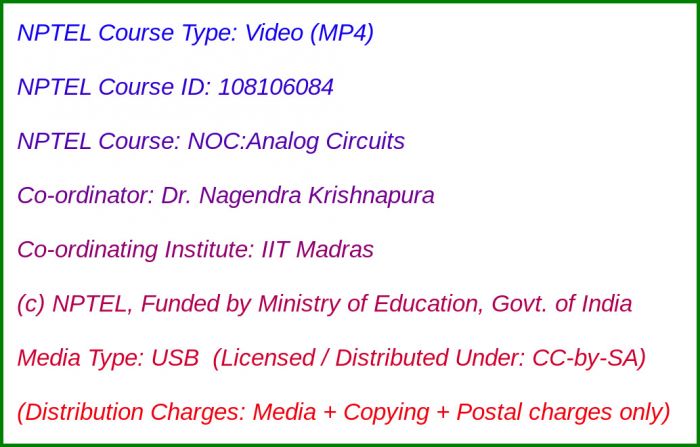
Media Storage Type : 32 GB USB Stick
NPTEL Subject Matter Expert : Dr. Nagendra Krishnapura
NPTEL Co-ordinating Institute : IIT Madras
NPTEL Lecture Count : 131
NPTEL Course Size : 3.7 GB
NPTEL PDF Text Transcription : Available and Included
NPTEL Subtitle Transcription : Available and Included (SRT)
Lecture Titles:
Lecture 1 - Introduction to the course
Lecture 2 - Obtaining power gain
Lecture 3 - Obtaining power gain using a linear two port?
Lecture 4 - One port (two terminal) nonlinear element
Lecture 5 - Nonlinear circuit analysis
Lecture 6 - Small signal incremental analysis - graphical view
Lecture 7 - Small signal incremental analysis
Lecture 8 - Incremental equivalent circuit
Lecture 9 - Large signal characteristics of a diode
Lecture 10 - Analysis of diode circuits
Lecture 11 - Small signal model of a diode
Lecture 12 - Two port nonlinearity
Lecture 13 - Small signal equivalent of a two port network
Lecture 14 - Small signal equivalent circuit of a two port network
Lecture 15 - Gain of a two port network
Lecture 16 - Constraints on small signal parameters to maximize the gain
Lecture 17 - Constraints on large signal characteristics to maximize the gain
Lecture 18 - Implications of constraints in terms of the circuit equivalent
Lecture 19 - MOS transistor-description
Lecture 20 - MOS transistor large signal characteristics
Lecture 21 - MOS transistor large signal characteristics - graphical view
Lecture 22 - MOS transistor small signal characteristics
Lecture 23 - Linear (Triode) region of the MOS transistor
Lecture 24 - Small signal amplifier using the MOS transistor
Lecture 25 - Basic amplifier structure
Lecture 26 - Problems with the basic structure
Lecture 27 - Adding bias and signal-ac coupling
Lecture 28 - Common source amplifier with biasing
Lecture 29 - Common source amplifier: Small signal equivalent circuit
Lecture 30 - Common source amplifier analysis: Effect of biasing components
Lecture 31 - Constraint on the input coupling capacitor
Lecture 32 - Constraint on the output coupling capacitor
Lecture 33 - Dependence of ID on VDS
Lecture 34 - Small signal output conductance of a MOS transistor
Lecture 35 - Effect of gds on a common source amplifier; Inherent gain limit of a transistor
Lecture 36 - Variation gm with transistor parameters
Lecture 37 - Variation of gm with constant VGS and constant drain current bias
Lecture 38 - Negative feedback control for constant drain current bias
Lecture 39 - Types of feedback for constant drain current bias
Lecture 40 - Sense at the drain and feedback to the gate-Drain feedback
Lecture 41 - Intuitive explanation of low sensitivity with drain feedback
Lecture 42 - Common source amplifier with drain feedback bias
Lecture 43 - Constraint on the gate bias resistor
Lecture 44 - Constraint on the input coupling capacitor
Lecture 45 - Constraint on the output coupling capacitor
Lecture 46 - Input and output resistances of the common source amplifier with constant VGS bias
Lecture 47 - Current mirror
Lecture 48 - Common souce amplifier with current mirror bias
Lecture 49 - Constraint on coupling capacitors and bias resistance
Lecture 50 - Diode connected transistor
Lecture 51 - Source feedback biasing
Lecture 52 - Common source amplifier with source feedback bias
Lecture 53 - Constraints on capacitor values
Lecture 54 - Sensing at the drain and feeding back to the source
Lecture 55 - Sensing at the source and feeding back to the gate
Lecture 56 - Ensuring that transistor is in saturation
Lecture 57 - Using a resistor instead of current source for biasing
Lecture 58 - Controlled sources using a MOS transistor-Introduction
Lecture 59 - Voltage controlled voltage source
Lecture 60 - VCVS using a MOS transistor
Lecture 61 - VCVS using a MOS transistor - Small signal picture
Lecture 62 - VCVS using a MOS transistor - Complete circuit
Lecture 63 - Source follower: Effect of output conductance; Constraints on coupling capacitors
Lecture 64 - VCCS using a MOS transistor
Lecture 65 - VCCS using a MOS transistor: Small signal picture
Lecture 66 - VCCS using a MOS transistor: Complete circuit
Lecture 67 - VCCS using a MOS transistor: AC coupling the output
Lecture 68 - Source degenrated CS amplifier
Lecture 69 - CCCS using a MOS transistor
Lecture 70 - CCCS using a MOS transistor: Small signal picture
Lecture 71 - CCCS using a MOS transistor: Complete circuit
Lecture 72 - CCVS using a MOS transistor
Lecture 73 - CCVS using a MOS transistor: Gain
Lecture 74 - CCVS using a MOS transistor: Input and output resistances
Lecture 75 - CCVS using a MOS transistor: Complete circuit
Lecture 76 - VCVS using an opamp
Lecture 77 - CCVS using an opamp
Lecture 78 - Negative feedback and virtual short in an opamp
Lecture 79 - Negative feedback and virtual short in a transistor
Lecture 80 - Constraints on controlled sources using opamps and transistors
Lecture 81 - Quick tour of amplifying devices
Lecture 82 - Signal swing limits in amplifiers
Lecture 83 - Swing limit due to transistor entering triode region
Lecture 84 - Swing limit due to transistor entering cutoff region
Lecture 85 - Swing limit calculation example
Lecture 86 - Swing limits-more calculations
Lecture 87 - pMOS transistor
Lecture 88 - Small signal model of the pMOS transistor
Lecture 89 - Common source amplifier using the pMOS transistor
Lecture 90 - Swing limits of the pMOS common source amplifier
Lecture 91 - Biasing a pMOS transistor at a constant current; pMOS current mirror
Lecture 92 - Converting nMOS transistor circuits to pMOS
Lecture 93 - Bias current generation
Lecture 94 - Examples of more than one transistor in feedback
Lecture 95 - Gain limitation in a common source amplifier with resistive load
Lecture 96 - nMOS active load for pMOS common source amplifier
Lecture 97 - CMOS inverter
Lecture 98 - Large signal characteristics of pMOS CS amplifier with nMOS active load
Lecture 99 - Large signal characteristics of nMOS CS amplifier with pMOS active load
Lecture 100 - Large signal characteristics of a CMOS inverter
Lecture 101 - Active load amplifiers as digital gates
Lecture 102 - Sensitivity of output bias to input bias in a CMOS inverter
Lecture 103 - Self biasing a CMOS inverter
Lecture 104 - An application of self biased inverters
Lecture 105 - Current consumption of a self-biased inverter; Current biasing
Lecture 106 - Amplifying a difference signal; Differential pair
Lecture 107 - Differential pair-small signal basics
Lecture 108 - Biasing a differential pair
Lecture 109 - Differential pair with differential excitation
Lecture 110 - Differential pair with a current mirror load
Lecture 111 - Differential pair with a current mirror load - operating point
Lecture 112 - Differential pair with a current mirror load - Norton equivalent current
Lecture 113 - Differential pair with a current mirror load - Norton equivalent resistance
Lecture 114 - Common mode gain
Lecture 115 - Single stage opamp
Lecture 116 - Single stage opamp: Input common mode swing limits
Lecture 117 - Single stage opamp: Output swing limits
Lecture 118 - Which transistor type to use for the second stage?
Lecture 119 - Small signal gain
Lecture 120 - DC negative feedback biasing of all stages
Lecture 121 - DC negative feedback biasing of all stages (Continued...)
Lecture 122 - Small signal model
Lecture 123 - Swing limits
Lecture 124 - Systematic offset; How to eliminate it
Lecture 125 - Bipolar junction transistor(BJT): Large signal model
Lecture 126 - BJT model for calculating operating points
Lecture 127 - BJT small signal model
Lecture 128 - Biasing a BJT
Lecture 129 - Biasing a BJT, (Continued...)
Lecture 130 - Amplifiers using BJTs
Lecture 131 - PNP transistor

